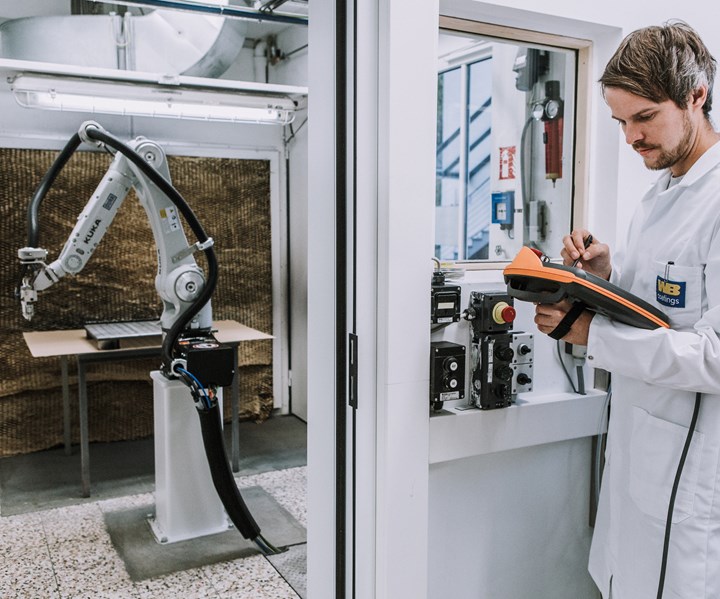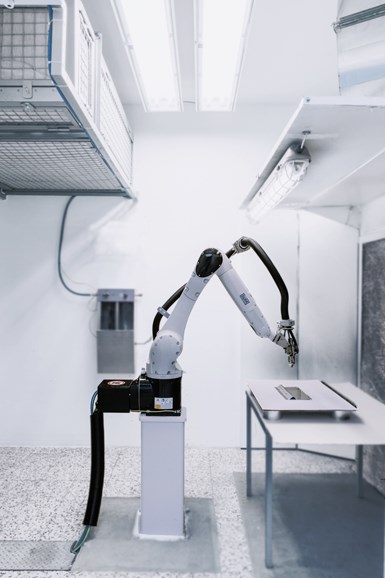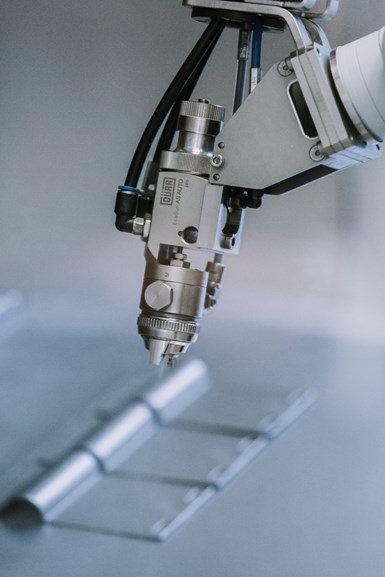Share

WB Coatings is now using the compact ready2spray robot from Dürr to test its new paints. Source | Dürr
Global paint and coating manufacturer WB Coatings (Schliersee, Germany) has been known for its innovations for more than 135 years. The company is known for the invention of hammertone paint and other specialty coatings, and continues to engage in research and development. WB Coatings’ in-house lab continuously optimizes the company’s recipes for the traditional industrial paint sector, while its innovation center focuses on new developments for various sectors.
Recently during the development of new specialty paints, WB Coatings reached the limits of typical manual application methods for applying paint evenly. The company decided to try adding a compact painting robot to its lab. WB Coatings opted for an automated paint application solution from Dürr (Bietigheim-Bissingen, Germany), becoming the first paint manufacturer to use the company’s “ready2spray” robot in the development of its new products.
One of the paint systems developed by WB Coatings is a new chrome-effect paint designed to give components made from plastic — such as vehicle interior components including window lift switches and decorative trim — a deceptively realistic chrome look. The paint system achieves this effect using one, two or three coating layers.
“Without using a robot, we would not have been able to develop these new paint systems as a chrome-free alternative for shiny, silver-colored surfaces,” explains Andreas Ohletz, Head of Sales for Innovations at WB Coatings. “The challenge is to apply the coating layers of the chrome-effect paint very evenly. And the three-layer paint system in particular needs very thin, reproducible coating layers of 2 to 3 µm. This is something even highly experienced hand painters can’t achieve.”
The Dürr ready2spray robot consists of a compact, six-axis robot EcoRP 10 R1100 with state-of-the-art application technology including mixing and dosing technology for two-component paints (2C), paint supply systems and controllers.

The six-axis compact robot EcoRP 10 R1100 is equipped with application technology and can be used to paint 3D objects with complex geometries. Source | Dürr
Industrial Series Production Modeled in the Lab
With coordinated and tested components, Dürr’s pre-installed, ready-to-paint robot is tailored to the requirements of the general industry — a combination that Dürr says makes the solution unique on the market. According to Dürr, the robot system’s automated spray program eliminates any deviations, and thus delivers maximum reproducibility. The process starts with dosing the components in the exact same ratio every time. Mixing the tiny quantities of just a few milligrams by hand poses too great a risk of inaccuracies. The painting result is also influenced by the application speed and the distance from the object to be painted. These factors inevitably vary with manual application, while the robot works completely uniformly and, as a result, produces identical coating layer thicknesses.
“A major benefit for us is the in-house tests that we can now conduct in our technical center with various base coats to test recipes. The robot lets us model automated industrial production and develop new paint systems that can make production more profitable for our customers involved in series production,” says Sebastian Grahammer, Head of Development in WB Coatings’ innovation center.

A wide range of application technology can be installed on the robot, for example the automatic spray gun EcoGun AS AUTO. Source | Dürr
Normally only sample panels and speed shapes are painted in the paint manufacturers’ labs. The flat spray system WB Coatings originally had in mind would have been sufficient for this. However, Grahammer is convinced that the decision to opt for the six-axis robot will give the paint manufacturer the flexibility to respond to customer requirements in the future.
“The robot lets us paint 3D objects with complex geometries,” he says. “With a 2D spray system, we would have limited ourselves in what we could develop.”
Since the application technology is already pre-installed, the Dürr robot system at WB Coatings was set up and ready to paint within just a day and a half. Its compact dimensions enabled it to be integrated into the existing painting booth despite the space constraints. When the robot is in the parked position, painting by hand is still possible in front of the same extraction wall.
Related Content
Shedding Light on Surface Inspection
State-of-the-art reflector-based lighting system improves luminosity and ergonomics for surface inspection tasks while reducing energy usage.
Read MoreProducts Finishing Reveals 2024 Qualifying Top Shops
PF reveals the qualifying shops in its annual Top Shops Benchmarking Survey — a program designed to offer shops insights into their overall performance in the industry.
Read MoreConveyors and Paint Systems
Choosing the right conveyor system, coating technology, and ancillary equipment.
Read MoreRobots, AI and Superb BMW Surfaces
There isn’t an automotive paint shop in the world that doesn’t have post-paint inspection and defect processing. But BMW is doing this with levels of technology at a plant in Germany that exceed all other paint shops in the world.
Read MoreRead Next
Delivering Increased Benefits to Greenhouse Films
Baystar's Borstar technology is helping customers deliver better, more reliable production methods to greenhouse agriculture.
Read MoreEducation Bringing Cleaning to Machining
Debuting new speakers and cleaning technology content during this half-day workshop co-located with IMTS 2024.
Read More















.jpg;maxWidth=300;quality=90)








